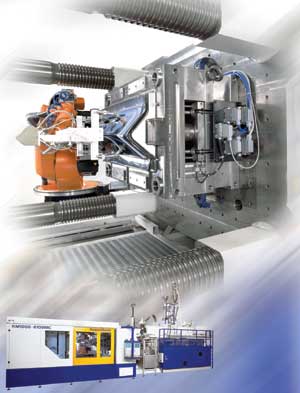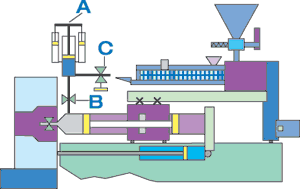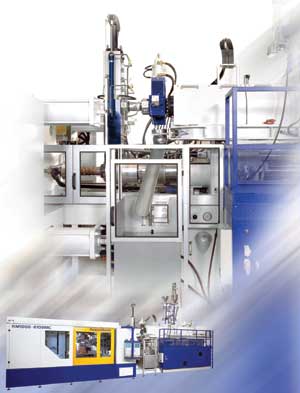Quality up, costs down with inline compounding
June 21, 2002
When Krauss-Maffei (KM) showed the prototype of its IMC (Injection Molding Compounding) system at K 1998 in Germany, IMM heard many people wondering who could possibly use it. At the same time, others—the early adapters—were forming ideas of how to use it. Many of the latter seem to have been from the automotive sector, for at last year's K Show it was clear the IMC system had taken root there. That is no surprise to KM: The molding-compounding combo is targeted at large parts needing reinforcement and/or additives.
At K 2001, a 1000-metric-ton IMC system produced a tailgate of glass-fiber-reinforced ABS that was inmold-decorated with multilayer film. The show system was bought by French auto supplier Faurecia, which has since added two more and ordered a fourth. Another two are working in Germany and one more is at an undisclosed molder in the U.S. IMC systems are now in serial production and can be purchased with KM's full range of clamps: 650 to 5400 metric tons. Each clamp can be paired with up to four injection—or should we say compounding—capacities.
In an IMC system, the reciprocating screw injection unit of a standard injection machine is replaced by a corotating twin-screw extruder and a special injection unit. Between those sits an accumulator that fills during injection and holding to form a buffer between continuous extrusion and intermittent injection. Compounded melt from the extruder is piston-fed from the accumulator to the injection unit. The accumulator and injection unit operate independently, separated by a control valve so that maximum pressure buildup is held during injection. Polymer and additives are gravimetrically metered into the extruder.
|
|
An industrial robot is shown removing an automotive tailgate panel (above) that has been inmold decorated using preformed film. |
|
In the IMC System, melt is forced from the extruder into the temperature-controlled melt buffer (A). The injection piston is retracted, permitting material to enter from extruder and buffer. When the shot volume is reached, a valve (B) closes off the buffer. Injection follows, during which the extruder continues feeding material into the buffer. A separate valve (C) shunts extrudate to a tank during startup and shutdown. |
Interlocking Advantages
Combining compounding and molding in one system can reduce production costs vs. two separate systems. It also means improved material quality as it is heated only once. Twin-screw compounding allows gentler plasticating of heat-sensitive compounds and a thorough mixing of virtually any conventional filler or reinforcement. KM also reports that reinforcing fibers are thoroughly coated, are evenly distributed in the melt, and can retain significantly more of their length than is possible in normal injection molding.
The twin screws in KM's IMC system are segmented. The segments can be varied to match the processing needs of a particular compound, including powdery or sticky mixes. Apart from customizing the screws, a basic twin-screw system provides a wide processing window and broad flexibility with formulations. Melt quality can be influenced by adjusting screw speed and/or varying the amount of material metered into the extruder. The system allows high shot weights for large parts like pallets or bumpers, or for parts in a stack mold.
The clamp of the IMC is the two-platen design of KM's MC Series injection machines and allows for large molds and stacks. A valve has been provided that opens during startup or during a fault to divert material from the extruder into a tank to prevent it from being injected. The system is designed so that no material remains in the buffer chamber from shot to shot. Similarly, the full volume is purged from the injection unit with each shot to avoid residue. A control valve between the melt buffer and injection unit allows them to operate independently to provide maximum injection pressure on each cycle.
|
The melt buffer enabling the crossover from continuous extrusion to intermittent injection is the tallest part above the injection unit it helps fill. |
The IMC system uses KM's MC4 injection control and its C4 extruder control. The operator panels are side by side for an easy view of the whole process, and the similarity of the interfaces is evident. The hardware components are identical, and the controls are linked on the software level so that operation of the two-part system is unified for the operator.
Besides applications development in areas such as automotive, furniture, and material handling, KM is working to broaden material options. Its engineers are collaborating with the Institute of Plastics Technology at the University of Stuttgart to advance the use of natural fiber in these molded composites. Results have been positive with flax/PP combinations, including the odor problem previously associated with intense heating of these fibers. Further research and development using hemp, jute, and other natural fibers in a variety of thermoplastic materials are ongoing.
Contact information |
You May Also Like





